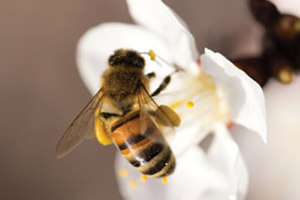
Air pollutants interact with and break down plant-emitted scent molecules, which insect pollinators use to locate needed food, according to a team of researchers led by Penn State. The pollution-modified plant odors can confuse bees and, as a result, bees’ foraging time increases and pollination efficiency decreases. This happens because the chemical interactions decrease both the scent molecules’ life spans and the distances they travel.
While foraging for food, insects detect floral scent molecules in the air. Wind currents can carry these molecules up to thousands of feet from their original source to where bees have their hives.
“Many insects have nests that are up to 3,000 feet away from their food source, which means that scents need to travel long distances before insects can detect them,” said Jose D. Fuentes, professor of meteorology and atmospheric science, Penn State. “Each insect has a detection threshold for certain kinds of scents and they find food by moving from areas of low concentrations of scents to areas of high concentrations.”
Plant-emitted hydrocarbons break down through chemical interactions with certain air pollutants such as ozone. This breakdown process results in the creation of more air pollutants, including hydroxyl and nitrate radicals, which further increase the breakdown rate of plant odors.
The researchers sought to understand how these chemical interactions, which start with the presence of air pollutants, would impact bees’ ability to find food. They first estimated the changes in concentrations of flower scents as a result of air turbulence and chemical interactions using a computer simulation, which allowed them to track the concentration and movement of multiple plumes of scents from different flower beds over time. Then, the researchers ran 90,000 simulations representing various bees’ foraging and movement patterns amid differing scent levels modified by air pollution and diluted by wind speeds.
The team reported in the current issue of Atmospheric Environment that, as air pollution increases, hydrocarbons’ lifetime and travel distance decreases. For example, at 60 parts per billion ozone levels, which the U.S. Environmental Protection Agency considers a ‘moderate’ level, the researchers found that enough chemical changes took place to thoroughly confuse bees and hinder their ability to identify the plumes of floral scents they needed to locate food.
The scent molecule alpha-pinene, which survives nearly 40 hours in an ozone-free environment, survived fewer than 10 hours when ozone rose to 60 parts per billion and only 1 hour when ozone was at 120 parts per billion. Another molecule, beta-myrcene, which travels more than 3,000 feet in an ozone-free, windy environment, traveled an average of 1,500 feet when ozone was 60 parts per billion and, when ozone rose to 120 parts per billion, most traveled fewer than 1,000 feet.
The changes in air chemistry impacted the number of bees able to detect food sources in a given time frame. In an ozone-free environment, it took 10 minutes for 20 percent of foragers to find the scent molecule beta-caryophyllene. When ozone rose to only 20 parts per billion, it took 180 minutes for the same amount of bees to find the scent. The team found similar results for the six different scent molecules they analyzed.
“We found that when we confused the bees’ environment by modifying the gases present in the atmosphere, they spent more time foraging and would bring back less food, which would affect their colonies,” said Fuentes. “It’s similar to being asked to get a cup of coffee at the nearest cafeteria while you are blindfolded. It will be hard to locate the coffee shop without using visual cues. The same could happen to insect pollinators while foraging for food in polluted air masses.”
Because the concentration of scents changes drastically in air polluted environments, this could impact important interactions between plants and insects.
“There are two types of pollinators, generalists and specialists,” said Fuentes. “Generalists can detect a mixture of scents, while specialists can only detect one type of scent. This means that as certain scents decrease their travel distance and life span, specialists and generalists may both have trouble finding food.”
Declines in the pollination of wild plants may lead to increases in the population of plants that do not rely on pollinators, and pollinator declines would lead to decreases in crop yields, Fuentes noted.
These findings highlight that air pollution is one of many factors influencing the decline of the bee population.
According to the U.S. Department of Agriculture, managed honeybee populations in the U.S. have declined between 25 and 45 percent per year since 2010, including a 44 percent decline from 2015 to 2016.
“Honeybees and other pollinators are in trouble almost …


